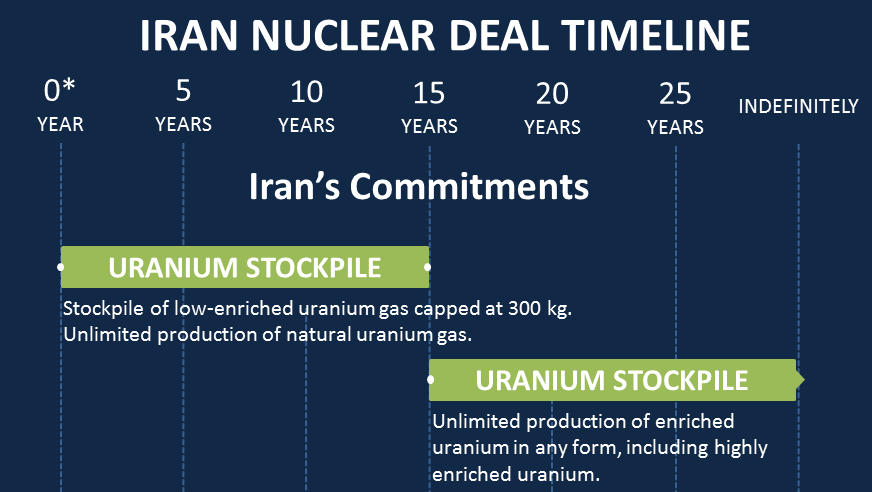 On the first anniversary of the nuclear deal with Iran, known as the Joint Comprehensive Plan of Action (JCPOA), Iran Watch is publishing a compendium of its year-long analysis of the agreement. Below are links to articles and reports written on various aspects of the implementation of the JCPOA, including: monitoring and verification; sanctions relief and compliance; licit and illicit procurement; the allegations of Iran’s past nuclear weapons-related work; and Iran’s ballistic missile program.
On the first anniversary of the nuclear deal with Iran, known as the Joint Comprehensive Plan of Action (JCPOA), Iran Watch is publishing a compendium of its year-long analysis of the agreement. Below are links to articles and reports written on various aspects of the implementation of the JCPOA, including: monitoring and verification; sanctions relief and compliance; licit and illicit procurement; the allegations of Iran’s past nuclear weapons-related work; and Iran’s ballistic missile program.
* * *
Iran Air, Prospective Buyer of Boeing Planes, Linked to North Korean Missile Shipments – July 12, 2016
“Iran Air was removed from the U.S. sanctions blacklist as part of the nuclear deal. Critics of the proposed Boeing sale have cited Iran Air’s links to the IRGC and the Syrian regime. But there is another troubling link that has gone unnoticed in the current debate: Iran Air’s suspected facilitation of ballistic missile cooperation between Iran and North Korea.”
Simmering Dissatisfaction on Both Sides of Nuclear Deal – April 20, 2016
“Secretary of State John Kerry and Iranian Foreign Minister Javad Zarif met in New York amid dissatisfaction on both sides about the implementation of the nuclear agreement. Iran has voiced frustration with the slow pace of financial sanctions relief promised by the agreement. The United States, meanwhile, is concerned about an increase in Iranian ballistic missile tests – an activity not directly addressed in the agreement but relevant to nuclear weapons.
New Guidance on U.N. Procurement Channel Raises Larger Questions about Iran Deal Enforcement”– March 17, 2016
“The U.N. procurement channel is just one example of how former restrictions on Iran’s nuclear program were removed faster than new enforcement structures could be put in place. It is unclear how long it will take for the United Nations, the new Joint Commission, and individual states to get the channel up and running–and whether sufficient information will be publicly released about the channel’s operations and decisions.”
Entities Removed from Official Blacklists on Implementation Day – January 29, 2016
“Implementation Day brought a first round of sanctions relief for Iran, including the removal of some 600 individuals and firms from E.U., U.S., and U.N. blacklists. To clarify the changes to the blacklists and support sanctions compliance, Iran Watch has created an Implementation Day spreadsheet that includes every entity that was removed (with the exception of individual vessels and aircraft). This spreadsheet will help support continued vigilance with regard to Iran.”
Questions Remain in ‘Final Report’ on Iran’s Alleged Weapons Work – December 10, 2015
“The IAEA released its long-awaited final report on Iran’s alleged past nuclear weapons work on Dec. 2. For most of the 12 issues, the IAEA, in the absence of new information or meaningful disclosures from Iran, has merely reiterated the evidence contained in the 2011 report. This ‘final’ report fails to present a complete picture of Iran’s past work on nuclear weapons.”
Major Iranian Nuclear Entities to Receive Early Sanctions Relief – November 18, 2015
“As part of the nuclear agreement with Iran, 36 entities will be removed from the United Nations blacklist when the deal is implemented. This represents about one-third of the entities on the U.N. list and covers entities that have been linked to undeclared nuclear work or illicit nuclear procurement. The removals also set in motion similar action by the E.U. and the U.S.”
Iran Nuclear Deal Timeline – November 9, 2015
What to Watch for after Implementation Day – October 5, 2015
“As Implementation Day approaches, three issues should receive more scrutiny: how any future illicit procurement by Iran will be handled; the flow of licit Iranian procurement through a newly-established “white channel”; and the agreement’s dispute resolution mechanism.”
Parchin: A Troubling Precedent for Inspections in Iran – September 3, 2015
“There appears to be little precedent for managed access procedures in which IAEA inspectors are physically restricted from a site completely and monitor verification activity remotely. Beyond the specifics of the investigation at Parchin, the reported arrangement could set a bad precedent for limiting access to other sites once the JCPOA is implemented.”
What the Iran Deal Says (and Doesn’t Say) about Iran’s Ballistic Missiles – July 30, 2015
“While Iran’s ballistic missile capabilities were not considered a core issue in the nuclear talks, the language of the new U.N. resolution and the terms of the JCPOA have consequences for the future of Iran’s ballistic missile program. Iran’s efforts to advance its nuclear-capable ballistic missile program – through test launches, production, and illicit procurement – will be made easier, while attempts to punish or deter Iran’s ballistic missile activity will be made more difficult.”
How Will Inspections Work in Iran under the Nuclear Deal – July 14, 2015
“President Obama said that inspectors from the IAEA will ‘be able to access any suspicious location. Put simply … the IAEA will have access where necessary, when necessary. That arrangement is permanent.’ But what does ‘where necessary, when necessary’ mean in practice? How will inspections work under the newly signed nuclear agreement? And will this inspections regime actually be ‘permanent’?”


